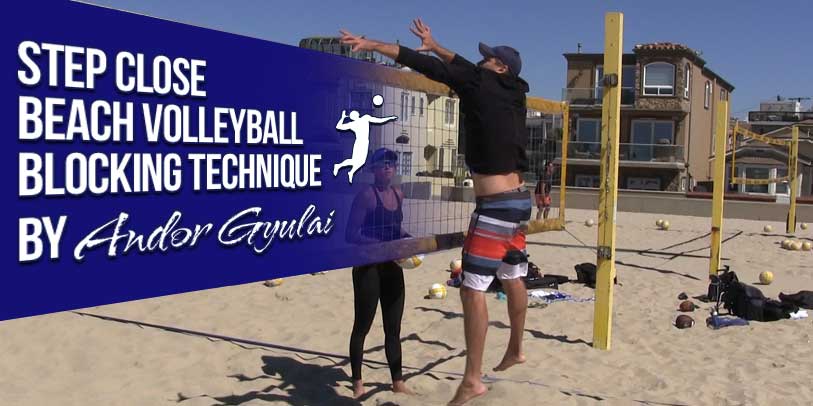This article and accompanying videos will introduce a new method of blocking in beach volleyball. With enough momentum, it could revolutionize blocking in beach volleyball.
I am calling this new blocking technique the “Step Close Beach Volleyball Blocking Technique.” My goal with this post is to change the method blockers use when playing beach volleyball. Enjoy and please let me know your thoughts by commenting below!
How I came up with this technique
I am human, which means I am as susceptible to Father Time as the next guy (with the exception of John Hyden, it seems). As a 41-year-old, I needed a new technique to jump higher while simultaneously increasing my mobility off and along the net as the game gets faster and offenses more unique.
Additionally, as I grew older, I also grew wiser, and I noticed the increasing need to optimize my tactics, using strategies like “Hicks Law” (the time is takes for a person to make a decision when presented multiple choices) and “OODA Loop for Reading the Game.” The Step-Close Blocking Technique will help you do both.
I have implemented this technique for both AVP and FIVB men and women, and every single one of them are enjoying success. Most prefer the Step-Close in just a few weeks. What is most exciting about this technique is that it is most efficiently used by younger high school players and female college and professional players where the need to pull is greater than it is in the men’s game.
The Step Close Beach Volleyball Blocking Technique offers 11 major benefits as opposed to regular beach volleyball blocking, where the player’s feet are parallel to the net. The 11 benefits include: Jumping higher, penetrating further, easier pulling, move differently for shots and hits, easier reading the hitters, easier closing out the hitter’s approach angle, a more aggressive mindset, better movement along the net for plays, better double-moves and fake blocks, stopping plays, deception when shaping the mind of your opponent and helping your partner on defense to “Read the Game Better.”
Introduction to the Step Close Blocking Technique and Why You Jump and Block Higher
Irrefutable: Players who use this technique will jump higher and thus block higher! A bigger block is a better block!
Step Close Allows You to Penetration Further and Its Easier to Focus on Specific Hands When Blocking (2 Versions)
Irrefutable: Players who use this technique will penetrate further over the net because they are jumping and blocking higher. Better penetration will produce better blocking!
When blocking in both beach and indoor, one hand – typically your outside hand on a line block or near the pin – tends to push straight into the ball while the other hand makes moves. The Step-Close footwork allows you to penetrate more and make better moves with your inside hand. This is a huge advantage!
Step Close Means It is Easier to Pull Off the Net When Blocking
Irrefutable: Players who use this technique will pull off the net faster and be ready to play defense quicker.
In beach volleyball, the blocker has two jobs: Block, or peel off the net on a bad set. In their starting position, most players focus only on the blocking and not the pulling. It is important to understand that, physically, it’s easier to move forward rather than backwards. This means players should start slightly off the net and move one or two steps forward, rather than having to move one or two steps back. The worse the pass, the more they should start off the net.
This is a crucial concept in women’s volleyball and in the lower levels. There are some levels of volleyball where a blocker should only block on tight sets. And yet, blockers are not maximizing their pulling potential, instead maximizing their block, which, at that level, is far less important than pulling.
Easier to Make Aggressive Moves Into the Hard Attack or For Shots.
The step close technique helps blockers across the net with the step. This is a huge advantage that allows blockers to move on an inside or outside set as well as make moves along the net for hard hits and shots. This means if you get a good read on the hitter and they are hitting angle and you are waiting on the line for example, you can step into that angle ball and take it. Same is true on a angle block in the middle. By step closing across the net you can effectively swat more shots and take a bigger angle jump if you get a good read!
I will plan to add a video on this in the next week!
Easier to Read the Game When Step Close Blocking
When blocking, your vision should go like so: Ball, setter, ball, hitter. When switching back onto the hitter, the less distance you have to turn your heads and eyes, the faster you can observe and orientate the hitter and thus get a good read.
I’ll use Ryan “Avatar” Doherty as my scapegoat for this. He is slow at switching back onto the hitter when he is reading. This is partly due to the fact that he is tight on the net, which results in a larger angle to switch back on the hitter after observing the setter and the ball. If he began slightly back, the play would be more in front of him, therefore cutting down his angle and making it easier for him to observe, orientate, and decide correctly.
See the example videos of Ryan below and by clicking here for older post!
Step Close Makes It Easier to Close the Hitter’s Approach Angle
In football, would a defensive player be more successful in stopping a running back if he were stopped or moving towards them and sealing off the angles? The answer is obvious: When they move forward and seal the angle. The same is true with blocking in volleyball.
Step Close Blocking Technique Leads to More Aggressive Moves and Mindset
In any sport, would you be more aggressive moving forward or moving sideways? With the Step Close Blocking Technique, players tend to be moving slightly forward as they block, thereby helping them penetrate over the net. This forward motion leads to a more aggressive mindset and players tending to aggressively grab the ball verses blocking the ball. Ideally, we want players having a “Grabbing Mindset” verses a “Blocking Mindset.”
See Olympic Gold Medal Coach Steve Anderson explain this important concept below.
Step Close Allows for Better Movement Along the Net and Its Better at Stopping Plays
The Step Close Blocking Technique allows for better movement along the net. It’s simple physics: It’s easier to move forward and sideways as opposed to moving exclusively sideways. In indoor volleyball, the best middle blockers in the world move slightly off the net when they know the ball is going to be set to the outside hitter. This allows them to move more effectively across the net and then penetrate on contact.
Additionally, the Step Close Blocking Technique is more effective at stopping plays. Again, it’s physics: It is easier to move along the net as well as pull on a play. It is important to remember how dynamic your feet can be when stopping plays, and your feet and hips will change based upon the pass, set, wind and play.
The Step Close Blocking Technique is Better for Double Moves and Fake Blocks
Step Close Blocking Technique Allows for Different Deception
As a beach blocker, one of your most important roles is creating deception, which breaks the rhythm and reaction time of the hitter as they go up to hit. This principle is derived from John Boyd’s ideas on the OODA Loop (our decision-making process). If we slow down their ability to observe, orient and make a decision, it will force them into Hicks Law (presenting multiple choices, delaying the time is takes to make a decision).
How “Hicks Law” applies to blocking: We want to present two, three, even four choices for the hitter to have to choose, and we want these choices to change rapidly, right in front of them. As the number of choices increases, their reaction time decreases. The Step Close Blocking Technique allows you to do this more effectively, as you will be able to block more seam swings.
Step Close May Help Your Partner Read The Game Better on Defense
Reading the Game is described by legends like Karch Kiraly as the most important skill in volleyball. Using the OODA Loop language defenders playing defense behind the block need to be able to see the attacker effectively in order to read. In some cases especially with sets outside the pin defenders “Observation” is not obstructed by the blocker fronting the hitter. This allows the defender to “Observe” and “Read” more effectively!
Step Close Blocking Technique Videos:
In this video series, I show the pulling technique based upon where you are on the court. Notice your feet switch based upon being middle or near the line, as well as the direction in which you are pulling. Players’ feet need to be dynamic in the process, following the pass, set, even the play.
More Coming In Match Situation!
Follow Up Video 1:
Example of Someone Who Should Use This In My Opinion:
Video 1:
Video 2:
Q and A:
1) Question: Does the other team not know what you are blocking if your feed give it away?
Answer: If we have them looking at our feet on their approach “Hicks Laws” is likely kicking in and they are going to have problems. Additionally the footwork on the antenna is the same for line or angle. From the middle it may change and you could give it away, however this 3 and 4 blocks can be done. Just because you have one type of footwork does not mean you cannot block the other type of ball. The primary reason for the footwork is to pull. Feet always ideally end up parallel as you block! Thus you can still block opposite your feet.
2) Questions? Please comment below and I will add answers here!








Isn’t the main concern with have a step approach your instability leading to easier flying past the hitter or touching the net? I think everyone agrees that you can jump higher and be more aggressive if you step into the block (or attack, or anything) but how do we avoid touching the net or miss-timing the block? All the best!
Hi Samuel, Thanks for the questions and feedback! Initially players may touch the net more! Also your timing may be worse. However with practice the benefits far outweigh those two negatives. I find with just a little practice most players timing becomes better because of the go get it mindset that is needed. Rather than waiting for the play player go and attack the play with the step-close blocking technique. The result is better timing because of the “Go Grab and Attack” mindset! Questions? 🙂 Thanks again!
Feel fee to try it and send some videos for review! 🙂